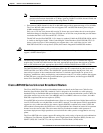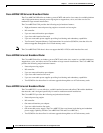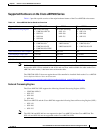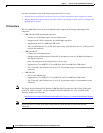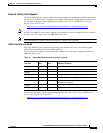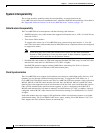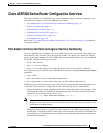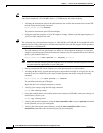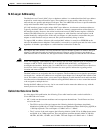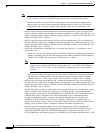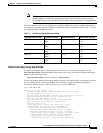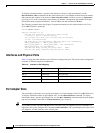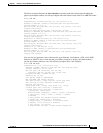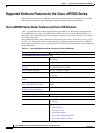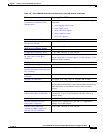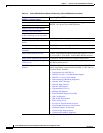
1-17
Cisco uBR7200 Series Universal Broadband Router Software Configuration Guide
OL-2239-05
Chapter1 Overview of Cisco uBR7200 Series Software
CiscouBR7200Series Router Configuration Overview
MAC-Layer Addressing
The Media Access Control (MAC)-layer or hardware address is a standardized data link layer address
required for certain network interface types. These addresses are not used by other devices in the
network; they are specific and unique to each port. The CiscouBR7200series uses a specific method to
assign and control the MAC-layer addresses for port adapters.
All LAN interfaces (ports) require unique MAC-layer addresses, also known as hardware addresses.
Typically, the MAC address of an interface is stored on a memory component that resides directly on
the interface circuitry; however, the online insertion and removal (OIR) feature requires a different
method. The OIR feature lets you remove a port adapter or cableinterface card and replace it with
another identically configured one. If the new port adapter or cableinterface card matches the port
adapter or cableinterface card you removed, the system immediately brings it online.
To support OIR, an address allocator with a unique MAC address is stored in an EEPROM on the
universal broadband router midplane. Each address is reserved for a specific port and slot in the router
regardless of whether a port adapter or a cableinterface card resides in that slot.
Note Port adapter and cableinterface card slots maintain the same slot number regardless of whether other port
adapters or cableinterface cards are installed or removed. However, when you move a port adapter or
cableinterface card to a different slot, the logical interface number changes to reflect the new slot number.
Caution When “hot swapping” a port adapter or cable interface line card with a different type of component (for
example, an MC11 FPGA with an MC11C, or an MC16B with an MC16C), you might have to
reconfigure the interfaces. Refer to the Cisco uBR7200 Series Universal Broadband Router Hardware
Installation Guide or appropriate FRU document for more specific information regarding online
insertion and removal (OIR).
The MAC addresses are assigned to the slots in sequence. The first addresses are assigned to port adapter
slot0 and slot1, and the next addresses are assigned to port adapter slot2 through cableinterface card
slot6. This address scheme allows you to remove port adapters or cableinterface cards and insert them
into other universal broadband routers without causing the MAC addresses to move around the network
or be assigned to multiple devices.
Storing the MAC addresses for every slot in one central location means the addresses stay with the
memory device on which they are stored.
Cable Interface Line Cards
As of the date of this publication, the following Cisco cableinterface cards can be installed in a
CiscouBR7200 series router:
• MC11 with one downstream modulator and one upstream demodulator. Two different revisions
exist for this card:
–
The FPGA version of the card supports the following defaults: Quadrature Amplitude
Modulation (QAM)-64 at 27Mbps downstream, and Quadrature Phase Shift Keying (QPSK) at
1.280 kbps upstream. The card outputs +32 dBmV and +/- 2 dBmV.
–
The C version of the card supports the following defaults: QAM-256 at 40Mbps downstream
and QAM-16 at 5Mbps upstream. The card supports upstream channel widths of 200kHz,
400kHz, 800kHz, 1.6MHz, and 3.2MHz. The card outputs +42dBmV and +/- 2dBmV.



